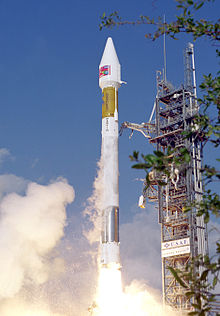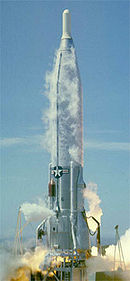Atlas II
 Launch of an Atlas II rocket | |
| Function | Medium expendable Launch vehicle |
|---|---|
| Manufacturer | Lockheed Martin |
| Country of origin | United States |
| Size | |
| Height | 47.54 m (156.0 ft) |
| Diameter | 3.04 m (10.0 ft) |
| Mass | 204,300 kg (450,400 lb) |
| Stages | 3.5 |
| Capacity | |
| Payload to LEO | |
| Mass | 6,580 kg (14,510 lb) |
| Payload to GTO | |
| Mass | 2,810 kg (6,190 lb) |
| Associated rockets | |
| Family | Atlas |
| Launch history | |
| Status | Retired |
| Launch sites | SLC-36, Cape Canaveral SLC-3 Vandenberg AFB |
| Total launches | 63 (II: 10, IIA: 23, IIAS: 30) |
| Success(es) | 63 (II: 10, IIA: 23, IIAS: 30)[1] |
| First flight | II: December 7, 1991 IIA: June 10, 1992 IIAS: December 16, 1993 |
| Last flight | II: March 16, 1998 IIA: December 5, 2002 IIAS: August 31, 2004[1] |
| Notable payloads | SOHO (Atlas IIAS) TDRS (Atlas IIA) |
| Boosters (Atlas IIAS) – Castor 4A | |
| No. boosters | 4 |
| Motor | 1 Solid |
| Thrust | 478.3 kN (107,500 lbf) |
| Specific impulse | 266 s (2.61 km/s) |
| Burn time | 56 seconds |
| Propellant | HTPB[2] |
| Boosters (all) – MA-5A | |
| No. boosters | 1 |
| Engines | 2 RS-56-OBA |
| Thrust | 2,093.3 kN (470,600 lbf) |
| Specific impulse | 299 s (2.93 km/s) |
| Burn time | 172 seconds |
| Propellant | RP-1 / LOX |
| First stage | |
| Engines | 1 RS-56-OSA |
| Thrust | 386 kN (87,000 lbf) |
| Specific impulse | 316 s (3.10 km/s) |
| Burn time | 283 seconds |
| Propellant | RP-1 / LOX |
| Second stage – Centaur | |
| Engines | 2 RL-10A |
| Thrust | 147 kN (33,000 lbf) |
| Specific impulse | 449 s (4.40 km/s) |
| Burn time | 392 seconds |
| Propellant | LH2 / LOX |
| Third stage – (optional) | |
| Engines | 1 R-4D |
| Thrust | 980 N (220 lbf) |
| Specific impulse | 312 s (3.06 km/s) |
| Burn time | 60 seconds |
| Propellant | N2O4 / MMH |
Atlas II was a member of the Atlas family of launch vehicles, which evolved from the successful Atlas missile program of the 1950s. It was designed to launch payloads into low earth orbit, geosynchronous transfer orbit or geosynchronous orbit. Sixty-three launches of the Atlas II, IIA and IIAS models were carried out between 1991 and 2004; all sixty-three launches were successes, making the Atlas II the most reliable launch system in history. The Atlas line was continued by the Atlas III, used between 2000 and 2005, and the Atlas V which is still in use.
Design[]
Atlas II provided higher performance than the earlier Atlas I by using engines with greater thrust and longer fuel tanks for both stages. and LR-105 were replaced by the RS-56, derived from the RS-27. The total thrust capability of the Atlas II of 490,000 pounds force (2,200 kN) enabled the booster to lift payloads of 6,100 pounds (2,767 kg) into geosynchronous transfer orbit (GTO) of 22,000 miles (35,000 km) or more. Atlas II was the last Atlas to use a three engine, "stage-and-a-half" design: two of its three engines were jettisoned during ascent, but its fuel tanks and other structural elements were retained. The two booster engines, RS-56-OBAs, were integrated into a single unit called the MA-5A and shared a common gas generator. They burned for 164 seconds before being jettisoned. The central sustainer engine, an RS-56-OSA, would burn for an additional 125 seconds.[3] The Vernier engines on the first stage of the Atlas I were replaced by a hydrazine fueled roll control system.[4]
This series used an improved Centaur II upper stage, the world's first cryogenic propellant stage, to increase its payload capability. Atlas II also had lower-cost electronics,[5] an improved flight computer[5] and longer propellant tanks than its predecessor, Atlas I.[5]
Versions[]
Atlas II[]
The original Atlas II was based on the Atlas I and its predecessors. This version flew between 1991 and 1998.[4]
Atlas IIA[]
Atlas IIA was a derivative designed to service the commercial launch market. The main improvement was the switch from the RL10A-3-3A to RL10A-4 engine on the Centaur upper stage.[6] The IIA version flew between 1992 and 2002.[7]
Atlas IIAS[]
Atlas IIAS was largely identical to IIA, but added four Castor 4A solid rocket boosters to increase performance. These boosters were ignited in pairs, with one pair igniting on the ground, and the second igniting in the air shortly after the first pair separated. The half-stage booster section would then drop off as usual.[6] IIAS was used between 1993 and 2004, concurrently with IIA.[8]
Background[]
In May 1988, the Air Force chose General Dynamics (now Lockheed-Martin) to develop the Atlas II vehicle, primarily to launch Defense Satellite Communications System payloads and for commercial users as a result of Atlas I launch failures in the late 1980s. Led by lead engineer Samuel Wagner,[citation needed] the Atlas II was crucial to the continued development of the United States' space program.
Atlas IIs were launched from Cape Canaveral Air Force Station, Florida, by the 45th Space Wing. The final West Coast Atlas II launch was accomplished December 2003 by the 30th Space Wing, Vandenberg AFB, California.
Specifications[]

- General Characteristics[9]
- Primary function: Launch vehicle
- Primary contractor: Lockheed Martin – airframe, assembly, avionics, test and systems integration
- Principal subcontractors: Rocketdyne (Atlas engine, MA-5); Pratt & Whitney (Centaur engine, RL-10) and Honeywell & Teledyne (avionics)
- Power Plant: Three MA-5A (RS-56) Rocketdyne engines, two Pratt & Whitney RL10A-4 Centaur engines
- Thrust: 494,500 lbf (2,200 kN)
- Length: Up to 156 ft (47.54 m); 16 ft (4.87 m) high engine cluster
- Core Diameter: 10 feet (3.04 m)
- Gross Liftoff Weight: 414,000 lb (204,300 kg)
- First Launch: February 10, 1992
- Models: II, IIA, and IIAS
- Launch Site: Cape Canaveral SFS, Florida
Atlas II first stage[]

The Atlas II first stage is a 3.04 m (10.0 ft) in diameter and 28.89 m (94.8 ft), the stage is powered by 3 RS-56 rocket engines burning 156 t (344,000 lb) of both RP-1 and Liquid oxygen. The Atlas II was the last Atlas rocket to use the "1.5 staging" technique, with this technique Atlas II ignite its 3 RS-56 engines at liftoff and then jettison the 2 RS-56-OBA side engines during ascent to only use the RS-56-OSA as this engine is more efficient in high altitude.
Compared to Atlas I the Atlas II booster stage is more higher[10] of 2.7 m (8 ft 10 in), it also support up to 4 Castor 4A solid boosters, each providing an additional 478.3 kN (107,500 lbf) of thrust for 56 seconds.
Centaur II upper stage[]
The Centaur II upper stage uses a pressure-stabilized propellant-tank design and cryogenic propellants. This Centaur is 9.06 m (29.7 ft) long, carrying 16 t (35,000 lb) of fuel, it use 2 RL-10A-3-3A engines.
For the 2A and 2AS version, Atlas uses the Centaur IIA variant which is 1 m (3 ft 3 in) longer than the Centaur II and use 2 RL-10A-4 engines.
- Centaur 2A pictures:

Centaur IIA arrives at Launch Complex 36A for the launch of GOES-L.

Centaur IIA before mating with Atlas II booster.

A close up view of RL-10 engines of Centaur IIA.

Centaur IIA of TDRS-I is lifted up.
See also[]
- Comparison of orbital launchers families
- Atlas (rocket family)
References[]
- ^ Jump up to: a b Tariq Malik "Final Atlas 2 Rocket Orbits Classified U.S. Satellite", Space News, August 31, 2004 (Accessed September 24, 2014)
- ^ Wade, Mark. "Castor 4A engine". astronautix.com.
- ^ "Atlas IIA(S) Data Sheet". Space Launch Report. Retrieved January 9, 2016.
- ^ Jump up to: a b "Atlas II". Astronautix. Retrieved January 9, 2016.
- ^ Jump up to: a b c "Atlas II Factsheet". au.af.mil. Archived from the original on May 1, 2017. Retrieved September 20, 2018.
- ^ Jump up to: a b "Atlas Launch System Payload Planner's Guide" (PDF). Lockheed Martin. Archived from the original (PDF) on April 21, 2015. Retrieved January 9, 2016.
- ^ "Atlas IIA". Astronautix. Retrieved January 9, 2016.
- ^ "Atlas IIAS". Astronautix. Retrieved January 9, 2016.
- ^ Spaceflight Now, Atlas IIAS (accessed September 24, 2014)
- ^ "Le lanceur Atlas 2". www.capcomespace.net. Retrieved February 14, 2021.
External links[]
- Atlas (rocket family)
- Lockheed Martin space launch vehicles





